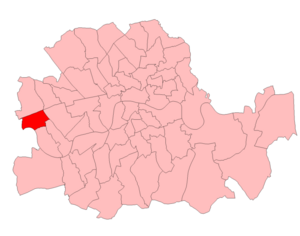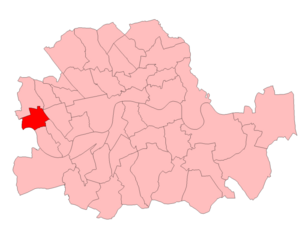Hammersmith South (UK Parliament constituency) facts for kids
Quick facts for kids {{{Name}}}[[{{{Type}}} constituency]] |
|
|---|---|
| [[Image:{{{Map1}}}Constituency.svg|120px|]] [[Image:England{{{Map2}}}.svg|120px|]] |
|
| {{{Name}}} shown within [[{{{Entity}}}]], and {{{Entity}}} shown within England | |
| Created: | {{{Year}}} |
| MP: | {{{MP}}} |
| Party: | {{{Party}}} |
| Type: | House of Commons |
| County: | [[{{{County}}}]] |
| EP constituency: | [[{{{EP}}} (European Parliament constituency)|{{{EP}}}]] |
Hammersmith South was a special area in west London that had its own representative in the UK Parliament. This area was called a "borough constituency." From 1918 to 1955, people living in Hammersmith South voted to choose one person to be their Member of Parliament (MP). An MP is like a spokesperson for their area in the House of Commons, which is a big part of the UK Parliament.
This constituency was created for the 1918 general election. It was formed when the older Hammersmith constituency was split into smaller parts. Hammersmith South stopped being a separate constituency for the 1955 general election. Its areas then became part of other constituencies, like Barons Court.
Contents
What Were the Boundaries of Hammersmith South?
The boundaries of a constituency show exactly which streets and neighborhoods are included. These boundaries can change over time.
Boundaries from 1918 to 1950
During these years, Hammersmith South included "wards" (smaller areas) numbers one, two, and three of the Metropolitan Borough of Hammersmith.
Boundaries from 1950 to 1955
For its last few years, the constituency's boundaries changed. It then included the Addison, Broadway, Brook Green, Grove, Olympia, Ravenscourt, and St Stephen's wards of the Metropolitan Borough of Hammersmith.
Who Were the Members of Parliament?
The people listed below were the MPs for Hammersmith South. They were elected by the people living in the constituency to represent them in Parliament.
| Election | Member | Party | |
|---|---|---|---|
| 1918 | William Bull | Conservative | |
| 1929 | Daniel Chater | Labour | |
| 1931 | James Cooke | Conservative | |
| 1945 | William Adams | Labour | |
| 1949 by-election | Thomas Williams | Labour | |
| 1955 | constituency abolished: see Barons Court | ||
A Look at the Election Results
Elections are how people choose their MPs. In Hammersmith South, voters used the "first-past-the-post" system. This means the candidate with the most votes wins, even if they don't get more than half of all votes.
Elections in the 1910s and 1920s
In the first election for Hammersmith South in 1918, William Bull from the Conservative Party won. He continued to win in the elections of 1922, 1923, and 1924. However, in 1929, Daniel Chater from the Labour Co-operative Party won the seat, ending the Conservative Party's winning streak.
Elections in the 1930s and 1940s
The 1931 election saw the Conservative Party win back the seat with James Cooke. He also won in 1935. After World War II, in the 1945 election, William Adams from the Labour Co-operative Party won, taking the seat back for his party. In 1949, there was a special election called a "by-election," and Thomas Williams also from the Labour Co-operative Party won.
Elections in the 1950s
Thomas Williams continued to represent Hammersmith South for the Labour Co-operative Party, winning the general elections in both 1950 and 1951. After the 1951 election, the Hammersmith South constituency was abolished in 1955.
Images for kids
-
Christopher Addison ran for MP in Hammersmith South in 1924.






